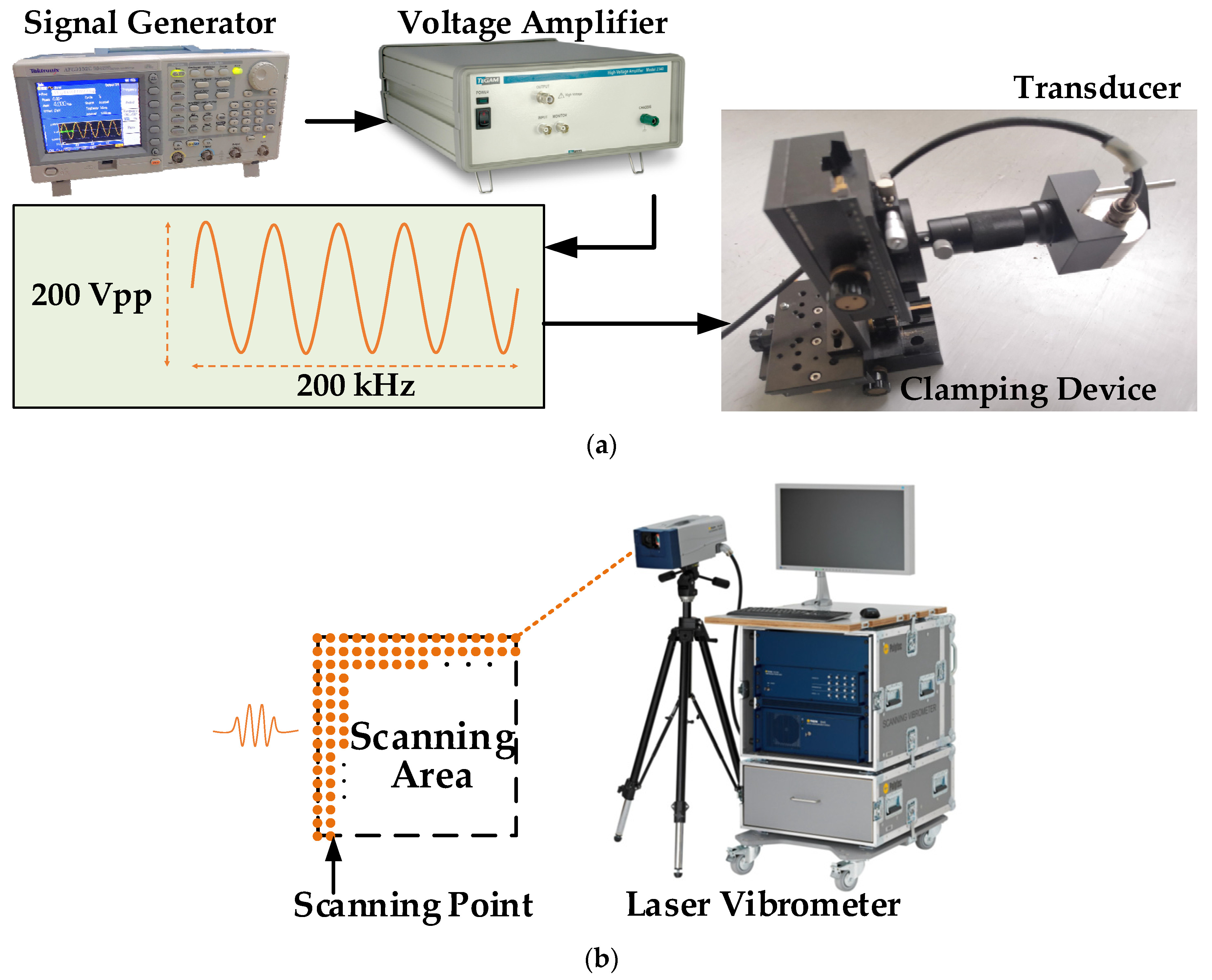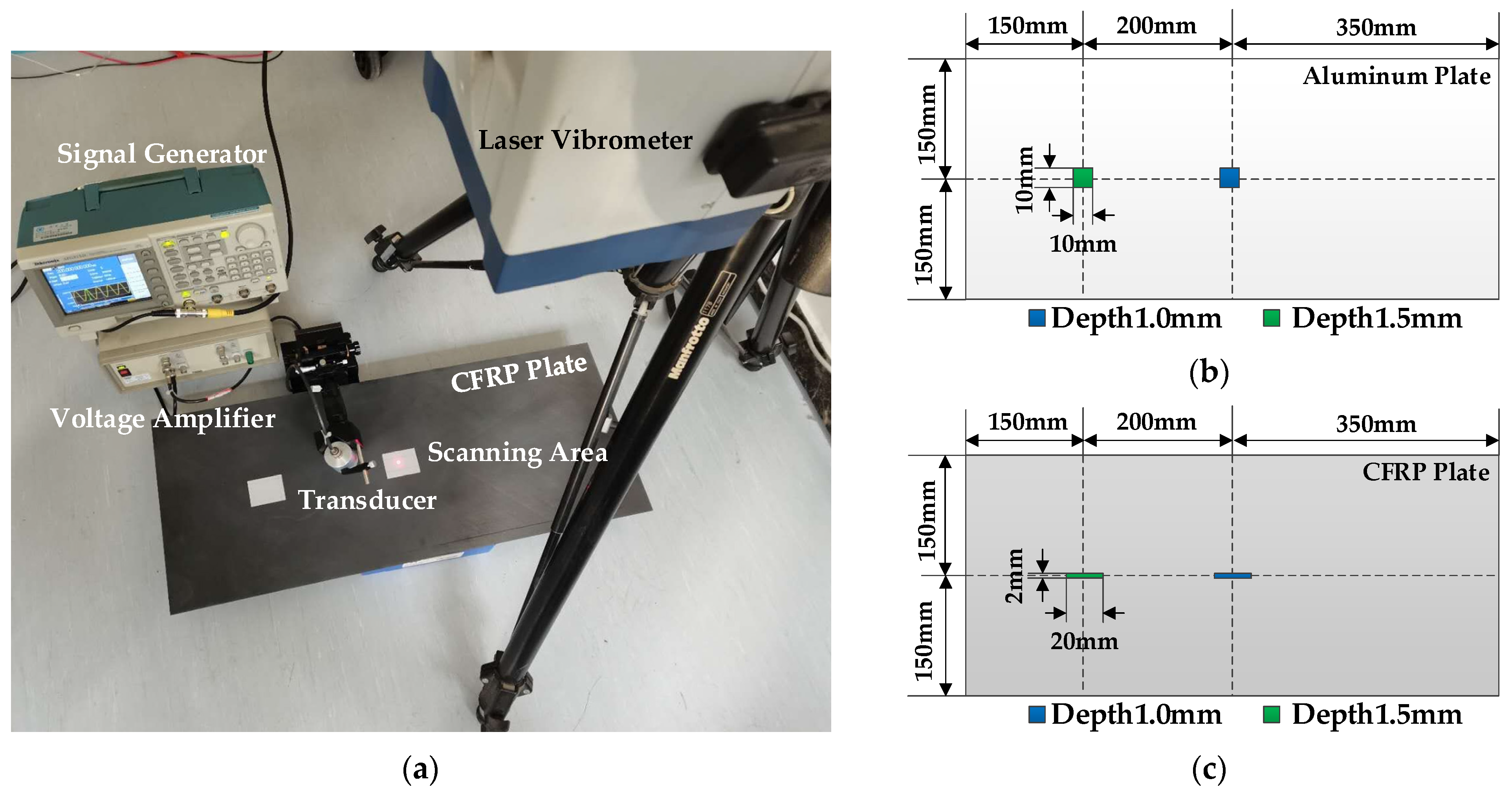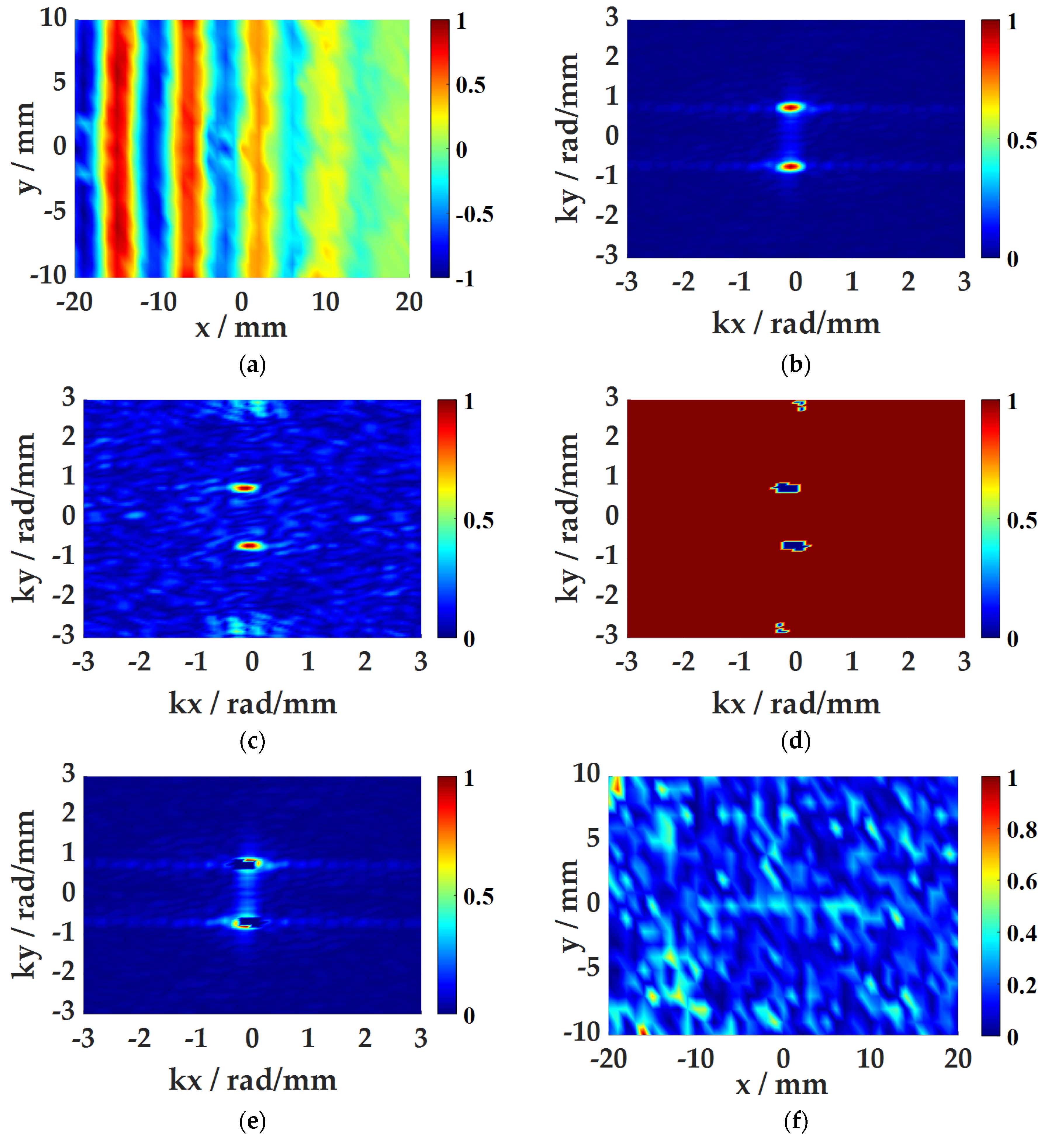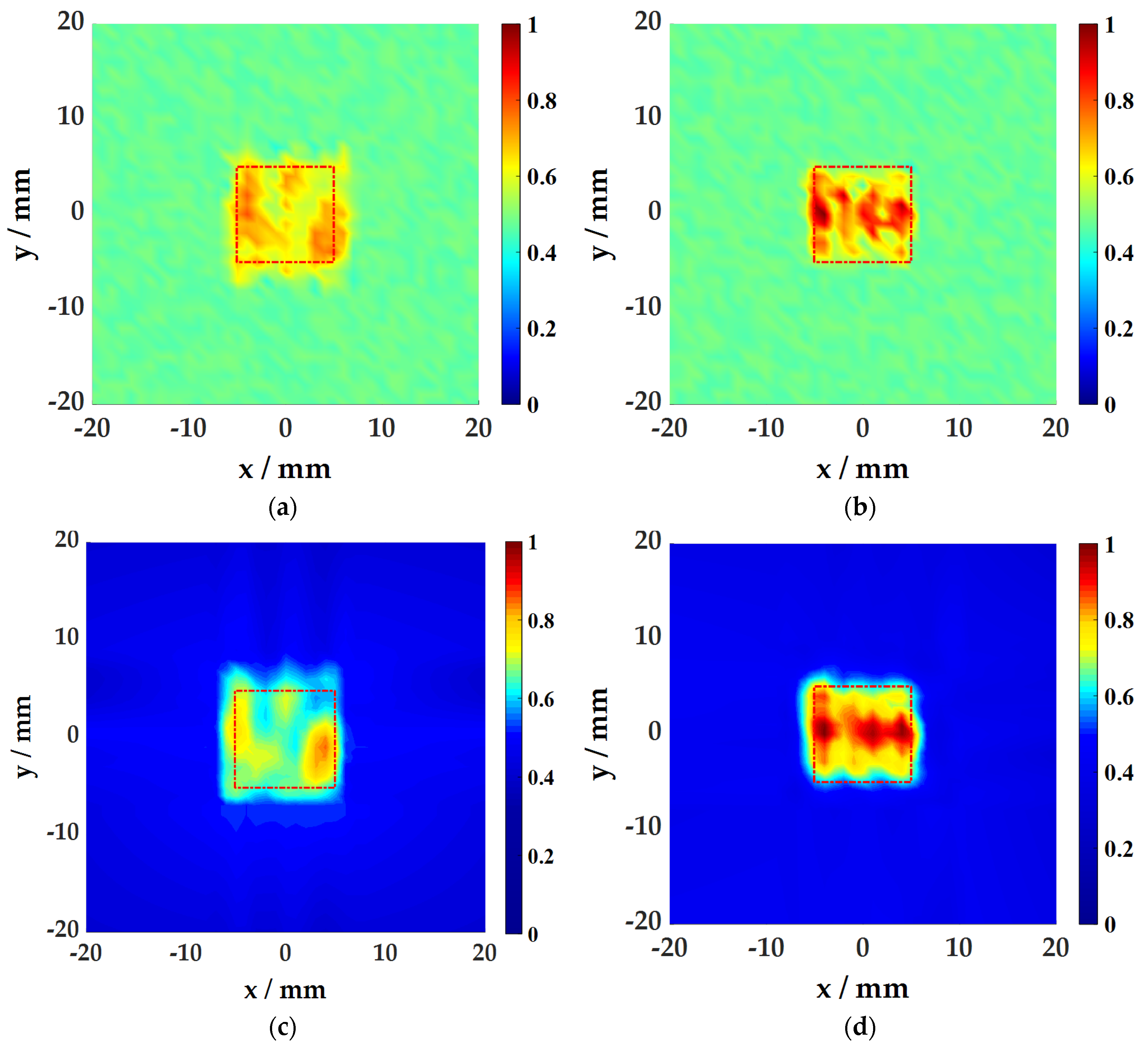Noncontact Damage Topography Reconstruction by Wavenumber Domain Analysis Based on Air-Coupled Ultrasound and Full-Field Laser Vibrometer
Abstract
1. Introduction
2. Air-Coupled Ultrasonic and Full-Field Laser Vibrometer Detection System
2.1. System Composition and Function
2.2. Excitation and Receiving Performance Testing of the System
2.2.1. Aluminum Alloy Plate
2.2.2. Carbon Fiber Reinforced Polymer(CFRP) Plate
3. Topography Reconstruction Algorithms
3.1. Wavenumber Filtering Algorithm (WFA)
3.2. Spatial Wavenumber Algorithm (SWA)
4. Results and Discussion
4.1. Experiment Platform
4.2. Topography Reconstruction Process
- (1)
- WFA
- (2)
- SWA
4.3. Topography Reconstruction Result
4.3.1. Aluminum Plate Damage Imaging
4.3.2. CFRP Plate Damage Imaging
4.4. Quality Assessment of Damage Imaging Results
- (1)
- WFA uses filtered time-domain sound field data for imaging, but the time-domain data have energy loss, which affects the imaging effect. The SWA is not affected by energy attenuation characteristics. It reflects the damage through the change of wavenumber information and has nothing to do with energy.
- (2)
- The filter function in the WFA has a great influence on the imaging effect, and the selection of the threshold is the core element that determines the imaging quality. When sound waves encounter damage, they will undergo changes such as refraction and reflection, which virtually increases the difficulty of threshold selection. The SWA has stronger stability, does not need to filter the spatial wavenumber, and reduces the cumbersomeness of selecting the filter threshold.
- (3)
- SWA selects a specific frequency range according to the bandwidth of the excitation signal, and averages the signals in the entire frequency band to generate a spatial wavenumber diagram, which basically covers most of the effective data signals, making the imaging results more accurate.
5. Conclusions
Author Contributions
Funding
Conflicts of Interest
References
- Yu, X.; Zuo, P.; Xiao, J.; Fan, Z. Detection of damage in welded joints using high order feature guided ultrasonic waves. Mech. Syst. Signal. Pr. 2019, 126, 176–192. [Google Scholar] [CrossRef]
- Fu, H.; Sharif-Khodaei, Z.; Aliabadi, M.H.F. An energy-efficient cyber-physical system for wireless on-board aircraft structural health monitoring. Mech. Syst. Signal. Pr. 2019, 128, 352–368. [Google Scholar] [CrossRef]
- Rautela, M.; Gopalakrishnan, S. Ultrasonic guided wave based structural damage detection and localization using model assisted convolutional and recurrent neural networks. Expert Syst. Appl. 2020, 114189. [Google Scholar] [CrossRef]
- Yan, W.J.; Chronopoulos, D.; Papadimitriou, C.; Cantero-Chinchilla, S.; Zhu, G.S. Bayesian inference for damage identification based on analytical probabilistic model of scattering coefficient estimators and ultrafast wave scattering simulation scheme. J. Sound Vib. 2020, 468, 115083. [Google Scholar] [CrossRef]
- Dafydd, I.; Sharif Khodaei, Z. Analysis of barely visible impact damage severity with ultrasonic guided Lamb waves. Struct. Health. Monit. 2020, 19, 1104–1122. [Google Scholar] [CrossRef]
- Bustamante, L.; Jeyaprakash, N.; Yang, C.H. Evaluation of Defect Detection in Aluminium, CFRP and Epoxy Resin Plates Using Non-contact Air-Coupled Ultrasonic Waves. Int. J. Precis. Eng. Manuf. 2020, 21, 1843–1856. [Google Scholar] [CrossRef]
- Meng, W.R.; Zhou, Z.G. Non-contact Detection of Debonding Defects in a Steel-Lead Adhesive Structure Using Laser Ultrasonic Technology. Lasers Eng. 2018, 41, 373–392. [Google Scholar]
- Lopez, B.; Syed, A. Advances in EMAT Technology and Applications. Mater. Eval. 2020, 78, 1017–1024. [Google Scholar] [CrossRef]
- Xiang, L.; Greenshields, D.; Dixon, S.; Edwards, R.S. Phased electromagnetic acoustic transducer array for Rayleigh wave surface defect detection. IEEE Trans. Ultrason. Ferroelectr. Freq. Control 2020, 67, 1403–1411. [Google Scholar] [CrossRef] [PubMed]
- Kudela, P.; Wandowski, T.; Malinowski, P.; Ostachowicz, W. Application of scanning laser doppler vibrometry for delamination detection in composite structures. Opt. Laser. Eng. 2016, 99, 46–57. [Google Scholar] [CrossRef]
- Zhang, Y.; Yue, G.; Qi, L.; Rui, X. Research on continuous leakage location of stiffened structure based on frequency energy ratio mapping method. J. Phys. D Appl. Phys. 2020, 53, 165301. [Google Scholar] [CrossRef]
- Yang, L.J.; Li, Y.; Sun, J.J.; Zou, Y. Reflection and Transmission of Laser Ultrasonic Waves on Surface Defects. Laser Optoelectron. Prog. 2019, 56, 041203. [Google Scholar] [CrossRef]
- Chang, J.J.; Wan, T.L. Probabilistic damage imaging of composite plates by air coupled Lamb waves. IEEE Far East NDT New Technol. Appl. Forum. 2019, 148–152. [Google Scholar] [CrossRef]
- Wang, X.; Wu, H.; Zhang, X.; Zhang, D.; Gong, X.; Zhang, D. Investigation of a multi-element focused air-coupled transducer. AIP Adv. 2018, 8, 095010. [Google Scholar] [CrossRef]
- Wang, X.; Gong, X.; Li, C.; Wu, R.; Cao, X. Low insertion loss air-coupled ultrasonic transducer with parallel laminated piezoelectric structure. AIP Adv. 2020, 10, 105331. [Google Scholar] [CrossRef]
- Hettler, J.; Tabatabaeipour, M.; Delrue, S.; Van Den Abeele, K. Linear and nonlinear guided wave imaging of impact damage in CFRP using a probabilistic approach. Materials 2016, 9, 901. [Google Scholar] [CrossRef]
- Zhang, H.; Liu, Y.; Rui, X.; Wang, Z.; Yu, L. Boundary-enhanced reconstruction algorithm for probabilistic inspection of composite plate defects with air-coupled Lamb waves. Smart. Mater. Struct. 2020, 29, 035019. [Google Scholar] [CrossRef]
- Wang, Z.; Qiao, P. Backward wave separation method in a single transmitter and multi-receiver sensor array for improved damage identification of two-dimensional structures. Int. J. Damage Mech. 2017, 26, 229–250. [Google Scholar] [CrossRef]
- Michaels, T.E.; Michaels, J.E.; Ruzzene, M. Frequency–wavenumber domain analysis of guided wavefields. Ultrasonics 2011, 51, 452–466. [Google Scholar] [CrossRef]
- Flynn, E.B.; Chong, S.Y.; Jarmer, G.J.; Lee, J.R. Structural imaging through local wavenumber estimation of guided waves. NDT E Int. 2013, 59, 1–10. [Google Scholar] [CrossRef]
- Tian, Z.; Yu, L.; Leckey, C. Delamination detection and quantification on laminated composite structures with Lamb waves and wavenumber analysis. J. Intel. Mat. Syst. Str. 2015, 26, 1723–1738. [Google Scholar] [CrossRef]
- Juarez, P.D.; Leckey, C.A. Multi-frequency local wavenumber analysis and ply correlation of delamination damage. Ultrasonics 2015, 62, 56–65. [Google Scholar] [CrossRef] [PubMed]
- Tian, Z.; Yu, L.; Leckey, C. Rapid guided wave delamination detection and quantification in composites using global-local sensing. Smart. Mater. Struct. 2016, 25, 085042. [Google Scholar] [CrossRef]
- Jeon, J.Y.; Gang, S.; Park, G.; Flynn, E.; Kang, T.; Woo Han, S. Damage detection on composite structures with standing wave excitation and wavenumber analysis. Adv. Compos. Mater. 2017, 26 (Suppl. S1), 53–65. [Google Scholar] [CrossRef]
- Kudela, P.; Radzieński, M.; Ostachowicz, W. Identification of cracks in thin-walled structures by means of wavenumber filtering. Mech. Syst. Signal. Pr. 2015, 50, 456–466. [Google Scholar] [CrossRef]
- Kudela, P.; Radzienski, M.; Ostachowicz, W. Impact induced damage assessment by means of Lamb wave image processing. Mech. Syst. Signal. Pr. 2018, 102, 23–36. [Google Scholar] [CrossRef]
- Radzieński, M.; Kudela, P.; Marzani, A.; De Marchi, L.; Ostachowicz, W. Damage identification in various types of composite plates using guided waves excited by a piezoelectric transducer and measured by a laser vibrometer. Sensors 2019, 19, 1958. [Google Scholar] [CrossRef]
- Harb, M.; Yuan, F. Non-contact ultrasonic technique for Lamb wave characterization in composite plates. Ultrasonics 2016, 64, 162–169. [Google Scholar] [CrossRef]
- Harb, M.S.; Yuan, F.G. Barely visible impact damage imaging using non-contact air-coupled transducer/laser Doppler vibrometer system. Struct. Health Monit. 2017, 16, 663–673. [Google Scholar] [CrossRef]













| Density kg/m3 | Elastic Modulus GPa | Shear Modulus GPa | Poisson’s Ratio | ||||||
|---|---|---|---|---|---|---|---|---|---|
| 1600 | E1 | E2 | E3 | G12 | G13 | G23 | v12 | v13 | v23 |
| 172 | 11.6 | 11.6 | 7.8 | 7.8 | 3.9 | 0.36 | 0.36 | 0.55 | |
| Damage-Depth | x True Length | y True Length | Method | x Measured Length | y Measured Length | Imaging Error | Weber Contrast |
|---|---|---|---|---|---|---|---|
| P1-1.0 mm | 10 mm | 10 mm | WFA | 12.6 mm | 11.7 mm | 21.5% | 0.36 |
| SWA | 12.1 mm | 11.3 mm | 17.0% | 0.49 | |||
| P2-1.5 mm | WFA | 11.3 mm | 9.5 mm | 9.0% | 0.44 | ||
| SWA | 11.2 mm | 10.3 mm | 7.5% | 0.93 |
| Damage-Depth | x True Length | y True Length | Method | x Measured Length | Imaging Error | Weber Contrast |
|---|---|---|---|---|---|---|
| P3-1.0 mm | 20 mm | 2 mm | WFA | 21.8 mm | 9.0% | 0.47 |
| SWA | 21.6 mm | 8.0% | 1.38 | |||
| P4-1.5 mm | WFA | 18.5 mm | 7.5% | 0.96 | ||
| SWA | 19.2 mm | 4.0% | 3.10 |
Publisher’s Note: MDPI stays neutral with regard to jurisdictional claims in published maps and institutional affiliations. |
© 2021 by the authors. Licensee MDPI, Basel, Switzerland. This article is an open access article distributed under the terms and conditions of the Creative Commons Attribution (CC BY) license (http://creativecommons.org/licenses/by/4.0/).
Share and Cite
Zhang, H.; Liang, D.; Rui, X.; Wang, Z. Noncontact Damage Topography Reconstruction by Wavenumber Domain Analysis Based on Air-Coupled Ultrasound and Full-Field Laser Vibrometer. Sensors 2021, 21, 609. https://doi.org/10.3390/s21020609
Zhang H, Liang D, Rui X, Wang Z. Noncontact Damage Topography Reconstruction by Wavenumber Domain Analysis Based on Air-Coupled Ultrasound and Full-Field Laser Vibrometer. Sensors. 2021; 21(2):609. https://doi.org/10.3390/s21020609
Chicago/Turabian StyleZhang, Hui, Dongmei Liang, Xiaobo Rui, and Zhuochen Wang. 2021. "Noncontact Damage Topography Reconstruction by Wavenumber Domain Analysis Based on Air-Coupled Ultrasound and Full-Field Laser Vibrometer" Sensors 21, no. 2: 609. https://doi.org/10.3390/s21020609
APA StyleZhang, H., Liang, D., Rui, X., & Wang, Z. (2021). Noncontact Damage Topography Reconstruction by Wavenumber Domain Analysis Based on Air-Coupled Ultrasound and Full-Field Laser Vibrometer. Sensors, 21(2), 609. https://doi.org/10.3390/s21020609






